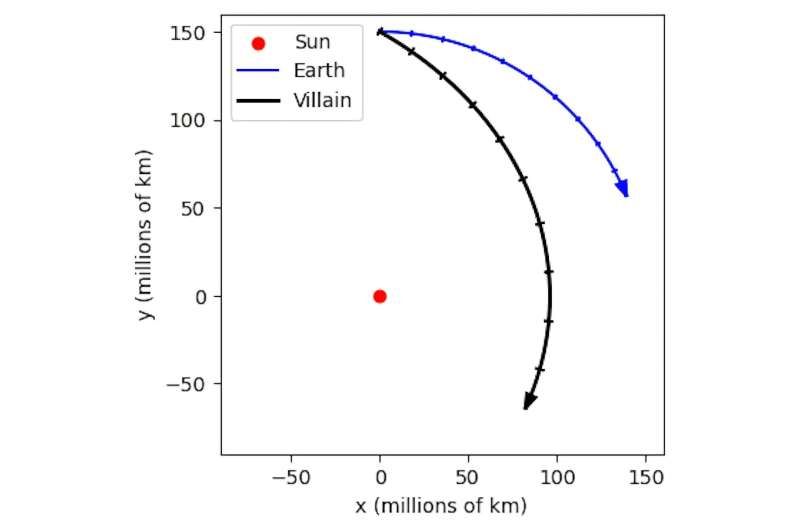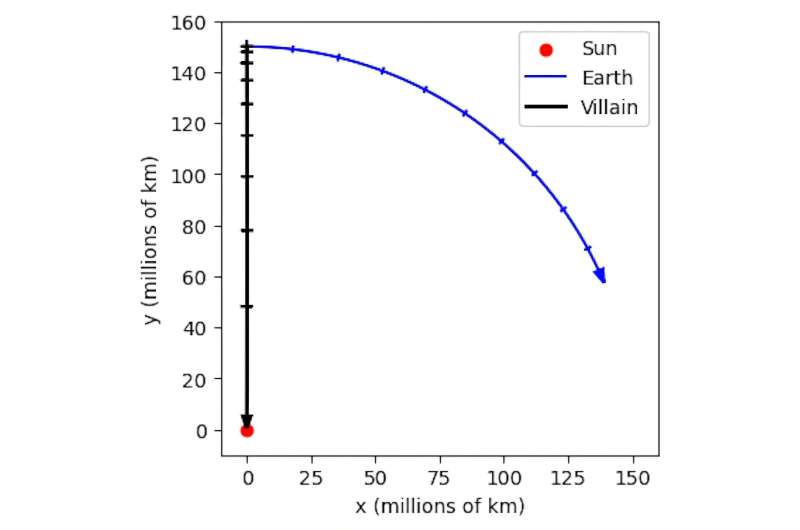We live in changing times. While we once flippantly threw villains to the lions, now we seek to fire them into the sun.
It sounds easy enough. The sun is unbelievably massive, with gravity sufficient to keep the planets in their orbits over billions of years. How hard can it be?
Well, it may be harder than you think.
Fire away
The obvious way to fire someone into the sun is the direct approach, as shown in South Park Season 1. Point a rocket at the sun and fire. But can that work?
For a start, the rocket has to reach a speed greater than 11 kilometers per second, so it doesn’t get stuck orbiting Earth. Fine—we can send off our rocket at 20km per second for good measure. What happens next?
The results are, to be honest, disappointing. It isn’t even close: we miss the sun by almost 100 million km.
But why? It’s because we have launched from Earth, which is traveling around the sun at 30km per second.
Consequently when our rocket leaves the proximity of Earth it is traveling faster around the sun than towards the sun. At first the rocket gets closer to the sun. But the motion of the rocket around the sun and gravity results in an elliptical orbit that misses the sun entirely.

To point a rocket directly at the sun and hit would require great speed—enough to dwarf Earth’s own speed, making it almost irrelevant to hitting the sun.
How fast, exactly? If we fire a rocket at 7,000km per second or more, then we finally hit the sun. Bingo—villain gone.
But achieving such an awesome speed is totally beyond our current technology. Is there another way?
Going sideways
Since our battle is really with the motion of Earth, let’s tackle that head-on. Rather than trying to launch directly at the sun, let’s launch a rocket to counteract Earth’s motion.
To do this, we would have a rocket leave low Earth orbit at 32km per second traveling in the opposite direction to Earth’s motion. If the sun was overhead, the rocket would be traveling almost horizontally due east.
Once the rocket leaves the proximity of Earth, its speed relative to the sun would be almost zero. At this point the sun’s gravity would pull the rocket (and the villain contained therein) inexorably inward.
Given this is a journey of 150 million km, the trip would take roughly 10 weeks—plenty of time for our villain to consider their sins before fiery destruction.

Will any sun do?
While counteracting the motion of Earth and falling into the sun is more practical than our first approach, there’s a big problem.
The fastest spacecraft ever to leave Earth was New Horizons, launched in 2006. It reached a speed of 16.26km per second after launch: well short of what we need to counteract the motion of Earth and fall into the sun.
In fact, New Horizons used Earth’s motion and kick provided by its rocket to fling itself towards Jupiter, Pluto and out of the solar system entirely. Because of Earth’s orbital speed, it would actually take less fuel to launch a (suitably deserving) person out of our own solar system towards another star rather than directly into our sun.
However, the distances to the nearest stars are more than 200,000 times the distance to the sun. The travel times are thus measured in millennia, and hitting the target would be an unprecedented feat of celestial navigation.
It’s about the journey
So is firing someone into the sun out of reach? Yes and no.
It’s true that current rockets cannot achieve the speed for a direct trip into the sun. But if we send a spacecraft into the solar system, we can use planetary flybys for a helpful push.
Interplanetary spacecraft have used planetary flybys to gain and lose speed by swinging around planets. For example, the Parker Solar Probe has used flybys of Venus to lower its orbit very close to the surface of the sun.
We can use the same process to get our villain into the sun. We can launch them into an orbit that takes them past the planets. With each planetary flyby their orbit is reshaped by gravity, taking our villain onto the next flyby and moving them closer and closer to the sun.
It will be a long journey—years and over many millions of kilometers—but finally our villain will meet their fate.
This article is republished from The Conversation under a Creative Commons license. Read the original article.![]()
Citation:
How do you fire someone into the sun? (2025, November 17)
retrieved 17 November 2025
from https://phys.org/news/2025-11-sun.html
This document is subject to copyright. Apart from any fair dealing for the purpose of private study or research, no
part may be reproduced without the written permission. The content is provided for information purposes only.

